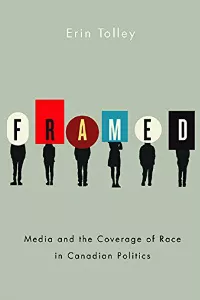
New book by UTM prof explores media bias in politics
Canadians take pride in the country’s reputation for inclusivity and diversity, but new research from U of T Mississauga shows that when it comes to politics, there’s room for improvement.
In her new book, UTM assistant professor Erin Tolley, of the Department of Political Science, examines how minority political candidates are treated by the mainstream press. Framed: Media and the Coverage of Race in Canadian Politics reveals that while overt racism rarely occurs on the pages of Canadian newspapers, assumptions about race and diversity often influence media coverage, to the detriment of democracy.

“I found there were real differences in the quality and focus of coverage that white and minority candidates received,” Tolley says. Articles about minority candidates were found to be more negative, received less prominence and were less likely to portray candidates as electorally viable. “Minority candidates were not included in conversations about key electoral issues like the economy,” she says. “This coverage can’t be explained by any factor other than their race.”
Tolley interviewed dozens of candidates and political staff who reflected on how they portrayed themselves and whether that information came through in the coverage of their campaigns. “Minority candidates felt they had been portrayed differently from what they put forward to media,” Tolley says. “They weren’t contacted for comment on important issues, and were more likely to be portrayed as subjects of their socio-demographic backgrounds. They expressed a sense that they couldn’t break through, and that they felt at a disadvantage.”
Tolley also had journalists revisit election stories to explain decisions about what they included or excluded in their reports. “I didn’t find any examples of racist reporting or people using ethnic slurs, but that doesn’t mean that the reporting was equitable or that visible minorities were being reported on in the same way as white candidates,” she says. “There is a tendency, when a candidate is a visible minority, to use that information to explain an outcome or set of beliefs. That doesn’t happen when the candidate is white. We can see this in coverage of Barack Obama. His racial background is used to partially explain his success. The coverage says ‘he won because he achieved support from the African American community,’ but nobody says ‘Bill Clinton won because white people supported him.’”
Better training would be an important step to more equitable reporting, Tolley says. Few journalists reported receiving specific training on how to handle race and ethnicity. “The Canadian Press Style Guide advises against mentioning a subject’s racial or ethnic background unless it’s relevant to the story, but it’s up to the journalist to decide what that means,” she says.
Tolley notes that many candidates work hard to manage their own brand to avoid being pigeonholed. One candidate said that when he speaks in the House of Commons, he posts the video to his website so people can see that he’s articulate and speaks without an accent. Others work to demonstrate expertise in areas unrelated to immigration and diversity issues, focusing on issues like education or seniors’ issues. “If a candidate can provide evidence that they are articulate, that they care about a range of issues and have broad appeal, it gives journalists raw materials to work with,” she says.
